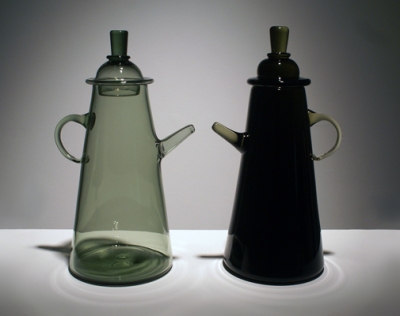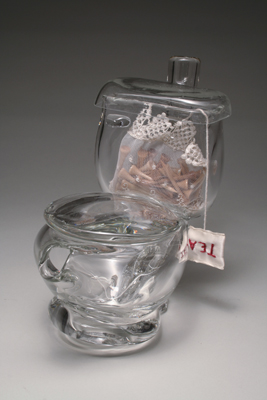 Angus Powers, Hollow and Solid, 2010. Blown and solid-worked glass. H 12, W 8, D 6 in. courtesy: morgan contemporary glass gallery.
Angus Powers, Hollow and Solid, 2010. Blown and solid-worked glass. H 12, W 8, D 6 in. courtesy: morgan contemporary glass gallery.
If you want to know what makes the teapot form so compelling, ask Amy Morgan, owner and director of Morgan Contemporary Glass Gallery, who has hosted an annual teapot exhibition for the past four years. Simply titled “teapots!,” her annual invitational exhibitions feature a wide variety of interpretations of this iconic form in glass, ceramic, metal, wood, found objects, and even fabric. The 2010 exhibition, which opened last Friday and continues through May 29th, includes 60 individual objects by 45 makers.
Morgan believes the attraction to the teapot form comes from its deep roots in culture and history. “If you look at the history of a teapot, you realize there was a time when drinking tea was a commonality,” she said in a telephone interview with the Hot Sheet. “People were brought together through the ritual. Because of this, the teapot has become an emblem of a culture.”
Today, teapots continue to be a focal point of people coming together, but in the case of her invitational exhibition, it is in appreciation for the sculptural possibilities of the form. Morgan said that the sculptural aspects of the teapots in her exhibition are a lot more important than their functionality, especially when the piece has a narrative component.
 Leslie & Lindsay Grigsby, Eclipse Teapot, 2010. Wood, thread, glass-seed beads, acrylic paint, gilding. H 7 1/2, W 10 3/4, D 3 1/2 in. courtesy: morgan contemporary glass gallery
Leslie & Lindsay Grigsby, Eclipse Teapot, 2010. Wood, thread, glass-seed beads, acrylic paint, gilding. H 7 1/2, W 10 3/4, D 3 1/2 in. courtesy: morgan contemporary glass gallery
Leslie & Lindsay Grigsby’s Eclipse Teapot (2010) fits this more narrative framework, with the spout, lid, and handle used to depict flame-like decorations around the Earth-like pot rendered in blue and white shades of glass beads.
Morgan held her first teapot invitational in 2006 when a friend gave her the idea. “I took her suggestion, and I got started on my first exhibition which was all glass,” she said. However, after the first year she decided not to limit the exhibition to just glass, “because I felt there was still room to find and commission artists who weren’t being used in other exhibitions.”
 Nadine Saylor & Eddie Bernard, Tea-pot Pot-Tea, 2009. Hot-sculpted glass, mixed media. H 9, W 6, D 12 in. courtesy: morgan contemporary glass gallery.
Nadine Saylor & Eddie Bernard, Tea-pot Pot-Tea, 2009. Hot-sculpted glass, mixed media. H 9, W 6, D 12 in. courtesy: morgan contemporary glass gallery.
Whimsy is in full flower in many of the teapots. For example, Nadine Saylor and Eddie Bernard worked together to create a dizzying, pun-filled teapot, that’s a multi-layered play on the words “tea” and “pot.” But not all the work in these exhibitions has been so light-hearted.
The November 2008 show took as its theme the “socio-economic climate” where the artists created interesting pieces about politics, global warming, world-hunger, etc. This year the show has an open theme which makes the diverse range of pieces flow well together, no matter the medium.
So what about the process of selection? How does an artist get selected for the show? Every year, Morgan invites new artists that her staff, other artists, and herself believe can and will create notable teapots for the exhibition.
“All artists are challenged to explore the teapot form literally, metaphorically, narratively or abstractly, while keeping true to their own aesthetic,” reads the Morgan website. The resulting work is a mix of artists who are already familiar with the teapot form, and those displaying their first explorations, all of whom have been invited to join her unique tea party.
—Apeksha Vanjari
IF YOU GO: teapots! 4th invitational Through May 29, 2010 Morgan Contemporary Glass Gallery 5833 Ellsworth Avenue Pittsburgh, Pennsylvania Website: www.morganglassgallery.com


